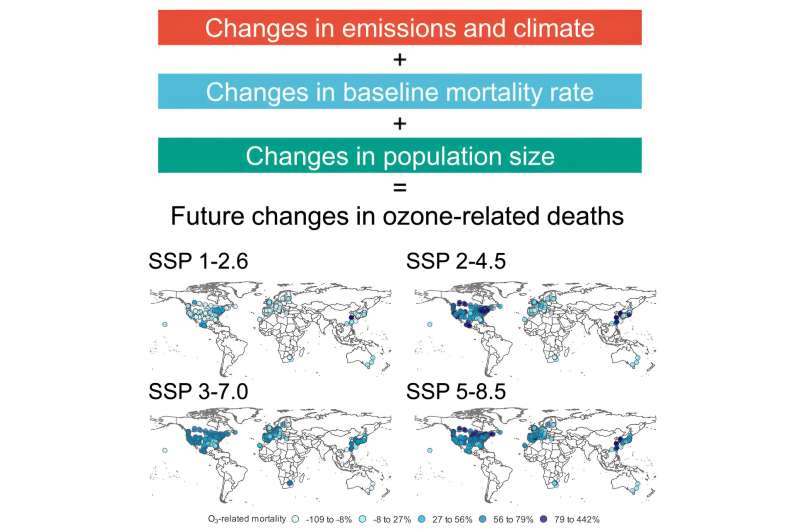This article has been reviewed according to Science X's editorial process and policies. Editors have highlighted the following attributes while ensuring the content's credibility:
fact-checked
peer-reviewed publication
trusted source
proofread
Ozone-related deaths projected to rise without stricter climate controls

An international study led by scientists at the Yale School of Public Health warns that ozone-related deaths will rise significantly in many parts of the world over the next two decades unless current climate and air quality regulations are strengthened.
The complete study is published in One Earth.
The findings are based on an examination of short-term exposure to ground-level ozone and daily mortality in 406 cities in 20 countries and regions. It is believed to be the geographically largest and most comprehensive investigation of this issue to date.
Poor air quality is the single largest environmental risk to human health. Ground-level ozone, a highly reactive gas that is the primary component of smog, makes breathing difficult. It has been linked to respiratory problems and cardiovascular disease and can lead to illness and premature death.
In conducting their study, researchers gathered epidemiological data from cities in North America, Europe, Asia, Australia, and Africa. They then used state-of-the-art CMIP6 climate model projections to calculate future ozone-related deaths under four different climate and air quality scenarios.
The study found that ozone-related deaths would increase by 45 to 6,200 people a year in those cities between 2010–2014 and 2050–2054. The projections varied based on the impact of different climate and regulatory scenarios as well as region-specific factors for different cities such as local climate, population size, mortality rates, and pollutant emissions.
In the scenario where strong climate and air quality controls were in place, ozone-related deaths were projected to increase by 0.7% between 2010–2014 and 2050–2054, the study said. In the scenario with weak climate policies but strong air quality regulations, ozone-related deaths would increase by 56%. In the scenario with both weak climate and air pollution controls—the increase was 94%.
One finding stood out.
When it came to determining mortality fractions—which is the number of ozone-related acute excess deaths divided by the total number of deaths—all of the scenarios saw an increase in ozone-related mortality (0.17% to 0.22%) except one. The one scenario that projected a decrease in the ozone-related mortality fraction (0.17% to 0.15%) adopted strict climate and air quality controls consistent with the international Paris Climate Agreement.
"This paper is further evidence of the health benefits that can be achieved if more countries adhered to the Paris Climate Agreement's goals," said Kai Chen, a senior author of the study and an assistant professor of public health (environmental health sciences) at the Yale School of Public Health.
"In all four of the climate scenarios we studied, only the scenario that aligns with the Paris Agreement would see a reduction in ozone-related mortality fraction in the future." Chen also serves as deputy faculty director of Yale's Center on Climate Change and Health.
Tighter climate and air quality controls are urgently needed, the scientists said, as human exposure to ground-level ozone is expected to increase in the years to come due to global warming, population growth, and the increased emission of pollutants.
Ground-level ozone is a major component of air pollution that is produced when atmospheric pollution from car exhaust, industrial processes, and volatile chemicals like paint thinner and other solvents interact with sunlight.
Currently, many countries' climate and air quality standards fall short of what is needed to mitigate the threat of ground-level ozone. In the present study, the scientists set 70 micrograms of ozone per cubic meter of air as the threshold for maximum allowable exposure, a standard adopted in similar assessments previously.
In contrast, the current air quality standard set by the World Health Organization is 100 micrograms. In the U.S. it is approximately 137, Europe 120, Mexico 137, and China 160.
"Our study highlights the need for more rigorous ozone standards," the scientists write in their conclusions. "Beyond mitigating ozone-related acute excess mortality, the implementation of stricter air quality regulations will likely yield additional benefits in terms of reducing long-term ozone-related mortality and conferring climate benefits."
More information: Nina G.G. Domingo et al, Ozone-related acute excess mortality projected to increase in the absence of climate and air quality controls consistent with the Paris Agreement, One Earth (2024). DOI: 10.1016/j.oneear.2024.01.001
Journal information: One Earth
Provided by Yale University




















